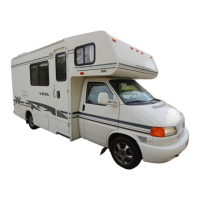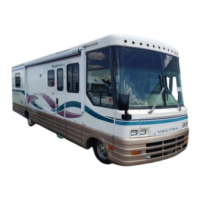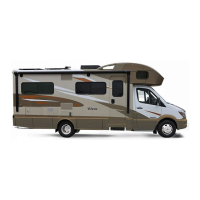Do you have a question about the Winnebago Voyage 2005 and is the answer not in the manual?
Overview of the motor home's limited warranty coverage and period.
Winnebago's commitment to repair or replace defective parts under warranty.
Owner's duties when a covered system or part fails during the warranty period.
Explanation of safety alert symbols (Note, Caution, Warning, Danger) used throughout the manual.
Key safety warnings and general driving advice for motor home operation.
Information on emergency exits and fire extinguisher inspection.
Proper use, care, and cleaning of seat belts for safety.
Guidance on loading the vehicle, understanding weight ratings, and distribution.
Step-by-step instructions for safely handling a flat tire situation.
Actions to take if the engine experiences extreme overheating.
Explanation of both foot-pedal and automatic pull-button parking brake systems.
Operation and safety precautions for hydraulic leveling systems.
How to operate the refrigerator and the importance of vehicle leveling.
Instructions for lighting and operating the range top burners and oven.
How to operate the water heater using gas, electric, or dual sources.
Instructions for starting up, shutting down, and troubleshooting the LP gas furnace.
How to set up and operate the thermostat for heating and cooling.
How to operate the optional heat pump and its interaction with the furnace.
Overview of the LP gas system, its supply, and basic principles of operation.
Essential safety warnings and precautions for handling and using LP gas.
Procedures for detecting gas leaks and responding to the LP gas alarm.
General precautions and safe practices for using the LP gas system.
Important electrical safety cautions and overview of the 12V DC and 110V AC systems.
How to connect the coach to an external power source via the shoreline cord.
Location and function of the 12V DC and 110V AC circuit breaker panels.
Importance and location of GFCI outlets for electrical shock protection.
Instructions for starting, stopping, and operating the auxiliary generator.
Details on chassis and house batteries, including storage and maintenance practices.
Automatic and stationary modes for slideout room extension and retraction.
How the fresh water system operates and procedures for filling the water tank.
Procedures for disinfecting the fresh water system using a chlorine solution.
How to operate the toilet, important 'don'ts', and cleaning instructions.
Procedures for dumping holding tanks and flushing the black water tank.
Comprehensive steps for winterizing the fresh water and waste water systems.
Operating the electric slideout room and managing travel straps.
Procedures for extending and retracting slideout rooms, including safety checks.
Troubleshooting common slideout room issues and using manual mode.
Understanding and clearing error codes for the slideout system.
Operating the hydraulic slideout room and securing travel straps.
Steps for relieving hydraulic pressure and manually retracting the room.
Recommended maintenance schedule for safety equipment and appliances.
Understanding GVWR, GAWR, GCWR, and hitch ratings for safe towing.
Guidelines for towing vehicles or trailers, including weight limits and hitch requirements.
Overview of the motor home's limited warranty coverage and period.
Winnebago's commitment to repair or replace defective parts under warranty.
Owner's duties when a covered system or part fails during the warranty period.
Explanation of safety alert symbols (Note, Caution, Warning, Danger) used throughout the manual.
Key safety warnings and general driving advice for motor home operation.
Information on emergency exits and fire extinguisher inspection.
Proper use, care, and cleaning of seat belts for safety.
Guidance on loading the vehicle, understanding weight ratings, and distribution.
Step-by-step instructions for safely handling a flat tire situation.
Actions to take if the engine experiences extreme overheating.
Explanation of both foot-pedal and automatic pull-button parking brake systems.
Operation and safety precautions for hydraulic leveling systems.
How to operate the refrigerator and the importance of vehicle leveling.
Instructions for lighting and operating the range top burners and oven.
How to operate the water heater using gas, electric, or dual sources.
Instructions for starting up, shutting down, and troubleshooting the LP gas furnace.
How to set up and operate the thermostat for heating and cooling.
How to operate the optional heat pump and its interaction with the furnace.
Overview of the LP gas system, its supply, and basic principles of operation.
Essential safety warnings and precautions for handling and using LP gas.
Procedures for detecting gas leaks and responding to the LP gas alarm.
General precautions and safe practices for using the LP gas system.
Important electrical safety cautions and overview of the 12V DC and 110V AC systems.
How to connect the coach to an external power source via the shoreline cord.
Location and function of the 12V DC and 110V AC circuit breaker panels.
Importance and location of GFCI outlets for electrical shock protection.
Instructions for starting, stopping, and operating the auxiliary generator.
Details on chassis and house batteries, including storage and maintenance practices.
Automatic and stationary modes for slideout room extension and retraction.
How the fresh water system operates and procedures for filling the water tank.
Procedures for disinfecting the fresh water system using a chlorine solution.
How to operate the toilet, important 'don'ts', and cleaning instructions.
Procedures for dumping holding tanks and flushing the black water tank.
Comprehensive steps for winterizing the fresh water and waste water systems.
Operating the electric slideout room and managing travel straps.
Procedures for extending and retracting slideout rooms, including safety checks.
Troubleshooting common slideout room issues and using manual mode.
Understanding and clearing error codes for the slideout system.
Operating the hydraulic slideout room and securing travel straps.
Steps for relieving hydraulic pressure and manually retracting the room.
Recommended maintenance schedule for safety equipment and appliances.
Understanding GVWR, GAWR, GCWR, and hitch ratings for safe towing.
Guidelines for towing vehicles or trailers, including weight limits and hitch requirements.
| Manufacturer | Winnebago |
|---|---|
| Model | Voyage |
| Year | 2005 |
| Category | Motorhomes |
| Width | 8.5 feet |
| Gross Vehicle Weight Rating (GVWR) | 22, 000 lbs |
| Fuel Type | Gasoline |
| Sleeping Capacity | 6 |












